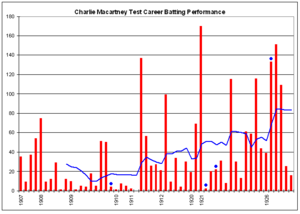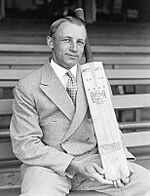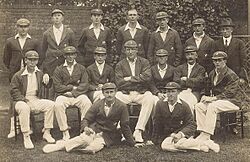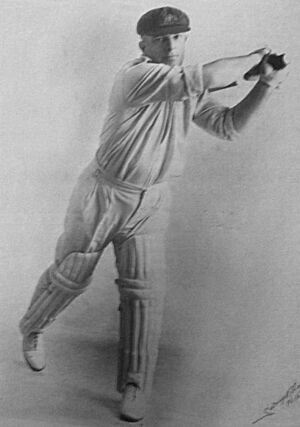Charlie Macartney facts for kids
 |
||||||||||||||||||||||||||||||||||||||||
| Personal information | ||||||||||||||||||||||||||||||||||||||||
|---|---|---|---|---|---|---|---|---|---|---|---|---|---|---|---|---|---|---|---|---|---|---|---|---|---|---|---|---|---|---|---|---|---|---|---|---|---|---|---|---|
| Full name |
Charles George Macartney
|
|||||||||||||||||||||||||||||||||||||||
| Born | 27 June 1886 West Maitland, New South Wales, Australia |
|||||||||||||||||||||||||||||||||||||||
| Died | 9 September 1958 (aged 72) Little Bay, New South Wales, Australia |
|||||||||||||||||||||||||||||||||||||||
| Nickname | The Governor-General | |||||||||||||||||||||||||||||||||||||||
| Height | 5 ft 3 in (1.60 m) | |||||||||||||||||||||||||||||||||||||||
| Batting | Right-handed | |||||||||||||||||||||||||||||||||||||||
| Bowling | Left-arm orthodox spin | |||||||||||||||||||||||||||||||||||||||
| International information | ||||||||||||||||||||||||||||||||||||||||
| National side | ||||||||||||||||||||||||||||||||||||||||
| Test debut (cap 90) | 13 December 1907 v England | |||||||||||||||||||||||||||||||||||||||
| Last Test | 14 August 1926 v England | |||||||||||||||||||||||||||||||||||||||
| Domestic team information | ||||||||||||||||||||||||||||||||||||||||
| Years | Team | |||||||||||||||||||||||||||||||||||||||
| 1905/06–1926/27 | New South Wales | |||||||||||||||||||||||||||||||||||||||
| 1909/10 | Otago | |||||||||||||||||||||||||||||||||||||||
| Career statistics | ||||||||||||||||||||||||||||||||||||||||
|
||||||||||||||||||||||||||||||||||||||||
|
Source: CricInfo, 24 October 2007
|
||||||||||||||||||||||||||||||||||||||||
Charles George Macartney (born June 27, 1886 – died September 9, 1958) was an Australian cricketer. He played in 35 Test matches for Australia between 1907 and 1926. People called him "The Governor-General" because of his strong batting style. He played with great flair, much like his friend and role model Victor Trumper.
Even the legendary Sir Donald Bradman, often called the greatest batsman ever, said Macartney's exciting batting inspired him. Charlie started his career as a bowling all-rounder, meaning he was good at both batting and bowling. He made his Test debut in 1907 as a left arm orthodox spin bowler and a useful lower-order batsman.
At first, his batting spot changed a lot, and he wasn't very effective. A highlight from his early career was taking ten wickets in a match at Headingley in 1909. After this, he became friends with Trumper and changed his batting style from defensive to very attacking. He got his Test spot back and scored his first Test century, becoming a top batsman for Australia.
The First World War stopped all major cricket games. Macartney joined the Australian Imperial Force. When cricket started again, Macartney became one of the world's best batsmen. This was clear during the 1921 Ashes tour. He made an Australian record score in England of 345 runs against Nottinghamshire. This was the fastest triple century in first-class cricket. It was also the highest score by a batsman in a single day. He reached 300 runs in just 205 minutes.
Macartney was the top scorer and had the best batting average on that tour. Because of his amazing performance, he was named one of the five Wisden Cricketers of the Year in 1922. Wisden, a famous cricket publication, called him "the most brilliant and individual Australian batsman of the present day." He missed the 1924–25 series due to health issues. Macartney left international cricket at the top of his game during the 1926 tour of England. He was the second Australian to score a century in the first part of a Test match. This was on a difficult pitch that helped bowlers. He scored three centuries in a row in Tests, leading the batting scores. In 2007, Macartney was added to the Australian Cricket Hall of Fame.
Contents
Charlie Macartney's Cricket Style
Charlie Macartney's exciting batting style was often compared to Victor Trumper. His strong determination was like that of Don Bradman. Even though his style was different from Trumper's, he impressed everyone with his daring and confidence.
Wisden in 1922 called Macartney "a triumph to individualism." They said he was "one of the most brilliant and attractive right-handed batsmen in Australian cricket history." His success came from his excellent eye, hand, and foot coordination.
Macartney was a short man, about 160 cm (5 feet 3 inches) tall. When he batted, he would try to hit yorkers (a type of fast ball) towards fine-leg. Sometimes he would lose his wicket doing this. He liked his teammates to give him honest feedback instead of just praise.
Later in life, he didn't like watching modern batsmen. He would say he couldn't stand seeing easy balls being hit gently back to the bowlers. A famous cricket writer, Sir Neville Cardus, said Macartney's cricket always showed "chivalry" and "heroism."
Macartney was a strong and aggressive batsman. His powerful hitting led a Kent cricketer, Kenneth Hutchings, to call him "The Governor-General." Early in his innings, Macartney would often try to hit the ball straight at the bowler's head. This was to make the bowler nervous and give him a mental advantage.
Once, after scoring a century before lunch, he asked for a heavier bat. He said, "Now I'm going to have a hit!" His scoring speed and boundary hitting then increased a lot. He had strong hands, forearms, and broad shoulders. His teammate, Leg spin bowler Arthur Mailey, remembered Macartney often hitting him for six in club games. Macartney would grin and say, "Pitch another one there and I'll hit you for a few more." Even when he got out trying for more big hits, he would still grin and say, "Wasn't it good fun?"
As a bowler, Macartney bowled quite fast for a left-arm orthodox spinner. He was known for bowling in the same spot consistently. He also had a hidden faster ball that often surprised batsmen. On sticky wickets (wet pitches), he was very effective. These conditions helped him take five wickets in an innings 17 times in his first-class career.
In 1909, his Australian teammate Victor Trumper moved close to where Macartney lived. Macartney and Trumper played together for Gordon Cricket Club and became close friends. Macartney often practiced on the Trumper family's backyard pitch. Trumper was seen as the best and most stylish batsman of his time. Under Trumper's influence, Macartney became more daring in his play. Macartney admired Trumper greatly. He was even a pall bearer at Trumper's funeral in 1915.
Unlike Trumper, Macartney was known for "walking." This means leaving the field before the umpire made a decision if a batsman knew they were out. Once, he felt so bad that an umpire didn't call him out when he clearly hit the ball. He tried to get out on purpose with a wild shot, but it went for six runs instead! Trumper, who was batting with him, told him that good luck would balance out bad luck later.
Early Years in Cricket
Charlie Macartney was born on June 27, 1886, in West Maitland, New South Wales. His grandfather, George Moore, taught him to play cricket. George was a slow bowler who played for New South Wales. Charlie used a small bat made of cedar wood and apples from the family orchard as balls.
In 1898, Macartney and his family moved to Sydney. At school, he was a great all-rounder at Woollahra Superior and Chatswood public schools. Macartney felt that school cricket wasn't as important as playing informal summer games with his brother in the local park. Their dog even acted as a fielder! During his school years, the Australian captain, Monty Noble, noticed Macartney and praised him in a newspaper.
After school, Macartney worked for a fruit and vegetable seller. He practiced batting without pads on a wooden wharf during his lunch break. At this time, he had a very proper and defensive batting style. Later, he would change this to his famous daring and attacking approach.
In 1902, Macartney joined the North Sydney Cricket Club. Then, in the 1905–06 season, he moved to the Gordon club. He played for Gordon until he was 47, scoring over 7,600 runs. He was known for being very dominant at the Chatswood Oval. In one game, he hit a ball out of the ground, over the railway line, and onto a lawn bowling green!
First-Class Debut
State selectors noticed Macartney's skills. He made his first-class debut for New South Wales against Queensland in the 1905–06 season. He scored 56 runs and took 3 wickets for 80 runs in a big win. He then scored 70 not out against South Australia. He finished the season with 185 runs and 15 wickets in six matches.
Macartney continued to improve in his second season (1906–07). He scored his first century, 122 runs, and took 4 wickets for 92 runs against Queensland. In the next match, he took his first five-wicket haul, getting 5 wickets for 18 runs against South Australia. He ended that season with 405 runs and 30 wickets in nine matches.
In the 1907–08 season, the England team visited Australia for a Test series. Macartney played against them for New South Wales. He was then chosen for an Australian XI team, scoring 42 runs and taking 4 wickets for 36 runs. Because of this, he was selected to make his Test debut against England. He was seen as a versatile player, good at both batting and his left-arm spin bowling.
Test Debut
Macartney had a decent Test debut. He didn't take any wickets in the first innings but scored 35 runs batting at No. 7. He took one wicket, that of English batsman Wilfred Rhodes. In the second innings, he was promoted to open the batting with Trumper but only scored nine runs. Australia still won the match by two wickets.
He kept his spot for the Second Test in Melbourne. He scored 37 runs in the first innings and 54 in the second. He also took one wicket. In the Third Test in Adelaide, he scored 75 runs and took two wickets in an Australian win. His batting was less effective in the last two Tests, but he took 5 wickets for 66 runs in the Fifth Test. Overall, in his first Test series, he scored 273 runs and took ten wickets. Australia won the series 4–0.
In the 1908–09 season, Macartney played well as an all-rounder. He took 6 wickets for 60 runs against South Australia and scored 100 runs in the return match. This earned him a spot on the 1909 tour of England, his first trip overseas.
First Tour of England
Macartney started his first tour of England well. He took 5 wickets for 86 runs against Northamptonshire. He took at least two wickets in each of the five matches before the Tests. He ended up with 17 wickets and 141 runs before the Test series began.
In the First Test, he took 3 wickets for 21 runs. In the Third Test at Headingley, his bowling confused the English team. He took 7 wickets for 58 runs in the first innings and 4 wickets for 27 runs in the second. This was his best bowling performance in Tests. It helped Australia win the Test and keep The Ashes. Macartney's batting in the Test series wasn't as successful, but his bowling was impressive. He took 16 wickets in the Tests. At this point, Macartney was mostly known as a bowling all-rounder.
After returning from England, Macartney played for Otago in New Zealand in 1909–10. He took 17 wickets and scored 132 runs there.
In the 1910–11 home series against South Africa, Macartney started poorly and was dropped from the Test team. However, he then scored 119 and 126 runs for New South Wales against South Africa. This led to him being recalled to the Test team. He then scored his first Test century, 137 runs, and 56 runs in the second innings, helping Australia win. He had scored three centuries in a row in first-class games.
Omission and Recall in 1912
Macartney was left out of the Australian team for some time in 1912. This was due to disagreements among the selectors. Australian captain Clem Hill wanted Macartney to play, but another selector, Peter McAlister, disagreed. These arguments caused a lot of tension.
Eventually, Macartney was called back for the Fifth Test against England. He scored 26 and 27 runs and took one wicket. Macartney later wrote that "persistent ill-feeling seriously affected the morale of the side."
Macartney then toured England again for the 1912 Triangular Test Tournament. He wasn't originally chosen, but several senior players pulled out due to a dispute with the cricket board. So, Macartney got a late call-up. He had a great tour, scoring 2,207 runs and taking 38 wickets. He made six centuries, including two in one match.
There were no more Test matches before the First World War. In the 1912–13 Australian season, Macartney was in amazing form, scoring 646 runs in just four matches. He also captained New South Wales for the first time. In 1913, he toured the United States and Canada, scoring 2,390 runs and taking 189 wickets. He topped both batting and bowling averages.
The 1913–14 season was the last before World War I. Macartney had another great season with the bat, scoring 892 runs in six matches. He scored 201 runs against Victoria and four other centuries.
Post-War Test Career
World War I stopped Macartney's cricket career. In 1916, he joined the Australian Imperial Force. He was sent to France in 1917. In 1918, he received the Meritorious Service Medal for bravery.
The war split Macartney's career into two parts. Before the war, he was known as a bowling all-rounder. In 21 Tests, he took 34 wickets and scored 879 runs with one century. After the war, Macartney became one of the best batsmen of his time. In his 14 post-war Tests, he scored 1,252 runs at a high average, with six centuries. He bowled less often, taking only 11 more wickets.
Macartney started playing Test cricket again when Australia hosted England in 1920–21. He was one of only four players from before the war. He only played in two Tests because of illness and injury. In the First Test, he scored 19 runs. His captain, Warwick Armstrong, moved him to number three in the batting order. In the second innings, he scored a flowing 69 runs.
Macartney missed the next three Test matches due to illness. After two months, he scored 130 runs for his state against England. He returned for the Fifth and final Test. He scored his highest Test innings of 170 runs at his home ground, the Sydney Cricket Ground. A 12-year-old Don Bradman was in the crowd that day. Decades later, Bradman remembered the innings clearly, calling it one of the best he had ever seen. Bradman said this innings inspired his own cricket career. Macartney led the Australian Test averages with 260 runs. Australia won the Ashes series 5–0.
Wisden Cricketer of the Year
On the 1921 Ashes tour, Macartney had a chance to improve his batting in England. He started strong with 177 runs against Leicestershire. He scored 87 against Surrey and 77 against Oxford University before the Tests began.
In the First Test, he scored 20 runs and was 22 not out as Australia won by ten wickets. This was Australia's sixth Test win in a row against England. He then hit three centuries in a row in county matches. He scored 105 against Hampshire and 193 against Northamptonshire. In the latter match, he scored 193 runs in just 135 minutes, hitting 31 fours.
His most famous innings was yet to come. In the next match, Macartney scored 345 runs against Nottinghamshire in 232 minutes. He hit 47 fours and four sixes. He was dropped when he had only nine runs, which he took as a sign that it was his day to shine. After reaching 200 runs in 150 minutes, he asked for a heavier bat and said he was going to attack. He kept his promise, scoring his next 100 runs in just 48 minutes. This was the fastest triple century in first-class cricket at the time. It is still the highest score by an Australian in England. Australia won the match by a huge margin.
In four days, Macartney scored 538 runs. In June, he scored 913 runs. He carried this great form into the next Test. In the Third Test at Headingley, he scored his first Test century outside Australia, making 115 runs. This helped Australia win and take an unbeatable 3–0 lead in the series.
Macartney finished the tour with 61 runs in the drawn Fifth Test. He led the scoring with 300 runs in the Test series. He topped the batting scores and averages for the whole tour, with 2,317 runs. Because of his amazing performances in 1921, he was named one of the 1922 Wisden Cricketers of the Year.
On the way back to Australia, the team stopped for their first Test tour of South Africa. Macartney scored 135 runs in a warm-up match. He then scored 59 and 116 runs in the First Test. In the Third Test, he scored 44 runs and took 5 wickets for 44 runs. Australia won by ten wickets. Macartney finished the Test series with seven wickets and topped the batting averages for the tour.
Macartney missed the 1924–25 Test series when England toured Australia. He played only two first-class matches due to health issues.
After his year off, Macartney returned to cricket in 1925–26. He scored 114 runs and took 4 wickets for 49 runs in his first match. He scored two centuries as New South Wales won all their matches. He scored 582 runs and took 20 wickets. This led to his selection for the 1926 tour of England.
International Farewell
Macartney's last international tour in England in 1926 saw him at his best in batting. He also bowled well. In the opening match, he took 5 wickets for 9 runs. In the next match, he scored 148 runs. He then scored 53 runs and took 6 wickets for 63 runs against Surrey. Before the First Test, he had scored 379 runs and taken 30 wickets.
The First Test was rained out. Macartney then scored 160 runs and took 5 wickets for 34 runs against Lancashire. In the Second Test at Lord's, he scored 39 runs and then 133 not out in the second innings to help save the match.
In the Third Test at Headingley, Macartney became only the second batsman to score a century before lunch on the first day of a Test. The pitch was wet and difficult for batting. The English captain won the toss and made Australia bat first. The first Australian batsman was out on the first ball. Macartney came to the crease and nearly got out on his second ball, but the English captain dropped the catch.
Macartney then took control. He hit the ball all over the field with many different shots. He especially targeted George Macaulay, whom he thought was England's best bowler. Macartney was so confident that he even ran down the pitch to hit the medium-pace bowlers, which was risky on that bouncy surface. He reached 40 runs in 40 minutes. Australia reached 100 runs in 79 minutes, with Macartney scoring 83 of them. He reached his century in 103 minutes. By lunch, he had scored 112 runs. He continued until he was out for 151 runs in 170 minutes. Former English captain Sir Pelham Warner said, "I have never seen a greater innings." Macartney's innings helped Australia score a big total of 494 runs. He then took 2 wickets for 51 runs.
Macartney then scored 109 runs in the Fourth Test, which was a rain-affected draw. He had scored three centuries in a row. His form dropped off after that. In the Fifth Test, he scored 25 and 16 runs and didn't take a wicket as England won the Test and the Ashes. Macartney still topped the batting averages for the series with 473 runs. He decided to retire from Tests after this tour.
End of Career
After returning to Australia, Macartney continued to play club cricket. He played one final first-class season. In 1926–27, he captained a Sydney City team against a New South Wales country team, which included the 18-year-old Bradman. Macartney scored 126 runs and Bradman scored 98 runs in a match that showed the change from one generation of Australian batting to the next. He scored 114 runs in his first match of the season and took wickets in all four of his matches.
In 1927, he toured Singapore and Malaya with a team. In 1929, he played for a New South Wales Cricket Association team in rural New South Wales.
In 1935–36, Macartney was vice-captain on a tour of India. He also wrote articles about the trip for The Hindu newspaper. In his return to first-class cricket after nine years, Macartney took 5 wickets for 17 runs and 3 wickets for 42 runs in the first international match against India. He took nine wickets in the series.
Outside Cricket
Macartney married Anna Bruce, a schoolteacher, in December 1921. At the time, a magazine noted that he was a "strict teetotaller and non-gambler" who loved his pipe, tennis, and music. When he wasn't playing cricket, Macartney worked as a civil servant. Like many Australian cricketers of his time, Macartney was Protestant and a freemason.
Macartney wrote for several Sydney newspapers. From 1936 to 1942, he regularly wrote for the Sydney Morning Herald. In 1930, he published his autobiography called My Cricketing Days. During the Second World War, he was a lieutenant in the Australian Defence Force. After the war, he worked as a personnel officer at Prince Henry Hospital.
Macartney and his wife did not have children. His wife passed away before him. He died of a heart attack while at work in Little Bay, New South Wales, at the age of 72. In February 2007, Macartney was added to the Australian Cricket Hall of Fame.
Test Match Performance
| Batting | Bowling | ||||||||
|---|---|---|---|---|---|---|---|---|---|
| Opposition | Matches | Runs | Average | High Score | 100 / 50 | Runs | Wickets | Average | Best (Inns) |
| 26 | 1,640 | 43.15 | 170 | 5/7 | 908 | 33 | 27.51 | 7/58 | |
| 9 | 491 | 37.76 | 137 | 2/2 | 332 | 12 | 27.66 | 5/44 | |
| Overall | 35 | 2,131 | 41.78 | 170 | 7/9 | 1,240 | 45 | 27.55 | 7/58 |






